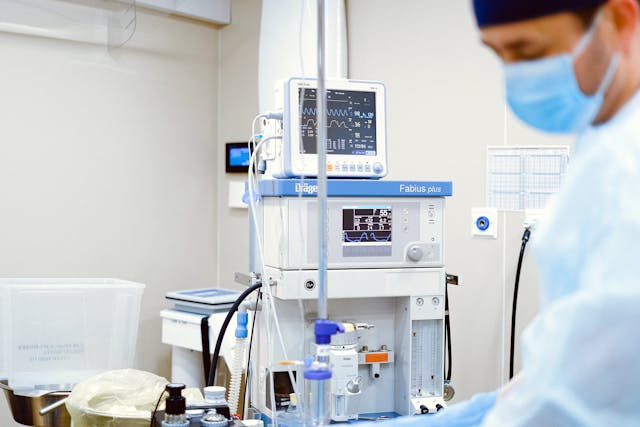
How does anesthesia work? Most anesthetics work by blocking the signals to nerves. There are some aesthetics where scientists don’t know how they work.
The word “anesthesia” comes from Greek, through Latin. The Greek word was anaisthesia, and it means “lack of feeling, perception, or sensation”. The route “an” means “without”. The word was only used in the medical sense from 1846.
There are different kinds of anesthetics. Some of them only numb part of your body (local) and some of them completely knock you out (general). General anesthetics generally simulate sleep, but on a much heavier level. You can be awoken even from a deep sleep, but you cannot (hopefully – although it does sometimes happen) be awoken from an anesthetic. It blocks out your reaction to the pain and shuts down your memory so that you don’t remember any of the process. How does it do that?
There are three parts of a general anesthetic. Those are pain elimination (analgesia), unconsciousness and lack of memory (amnesia), and muscle relaxation. There is not one single type of anesthetic drug and sometimes a combination of drugs are necessary. One drug might shut down the body’s reaction to pain but not cause unconsciousness. There are obvious reasons why these three things are necessary. Pain elimination has to happen because there is a shock response to excessive pain. If we undergo severe pain from an injury, our breathing, heart rate, and blood pressure will all rise. If the pain shock response isn’t controlled, this can be fatal. In fact, in the early days of anesthesia, a lot of people died from this shock response. Unconsciousness and lack of memory are necessary so that the brain doesn’t need to process what has happened. This can speed up healing. And muscle relaxation is obviously necessary because the patient needs to be still during the procedure so that the surgeon can accurately get to what they are trying to fix or remove. However, the difficulty with muscle relaxants is that the muscles we use for breathing and pumping blood need to keep going. The anesthesiologist has to keep a constant watch on the patient’s vital signs so that they can adjust the drugs as necessary.
A number of different drugs are used to achieve these results. The most common drug to induce unconsciousness is called propofol. At low levels, it can induce unconsciousness but allows the person to keep breathing. At higher doses, it will shut down the lungs. The drugs used to stop the pain response are opioids. Ketamine is often used as a sedative and a muscle relaxant.
The interesting thing is that people don’t really know how these drugs work the way that they do. All of the nerves in your body send their signals to your brain. And every command to move your muscles has to come from your brain. They only way anesthetic drugs can work is by impeding these signals. The different drugs work in different ways. A lot of research has been done into them and there is no conclusive proof for how the work. A theory related to propofol is that it restricts the movement of the proteins that help communication between neurons in the brain. This stops signals being passed. Another theory is that these drugs can make the body release inhibitory neurotransmitters, which also stop the neurons passing signals. Whatever the reason, the drugs are preventing the brain from receiving signals or from sending signals. And yet, they don’t completely shut down all signals.
Anesthesia is a lot safer now than it used to be. The risk of a general anesthetic is three deaths in every 10,000 operations. That is much lower than your chance of dying in a car crash. Statistically, in the US at least, you have a 100 in 10,000 chance of dying in a car crash during your lifetime. Study into anesthesia has existed ever since people have injured themselves, but it was only in the 18th century when science became advanced enough to make much progress. Before then, alcohol, ether, and plant based drugs were the only available anesthetics and most operations were performed with the patient conscious. In the early 19th century, cocaine, ether, chlorophyl, and nitrous oxide (laughing gas) were common. Since then they have all been replaced by safer drugs. Except for laughing gas, which is still used, especially in dentists. And this is what I learned today.
Sources
https://www.nigms.nih.gov/education/fact-sheets/Pages/anesthesia
https://en.wikipedia.org/wiki/Anesthesia
https://www.etymonline.com/word/anesthesia
https://en.wikipedia.org/wiki/Propofol
https://www.dea.gov/factsheets/ketamine
https://www.apsf.org/patient-guide/what-drugs-are-used-in-anesthesia
https://www.injurylawyers.com/blog/the-odds-of-dying-in-a-car-crash
Photo by Anna Shvets: https://www.pexels.com/photo/a-medical-professional-wearing-face-mask-while-standing-near-operating-room-4483340/
